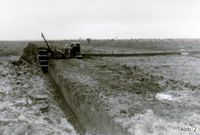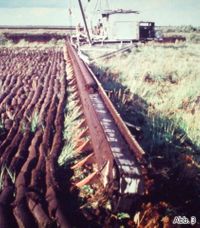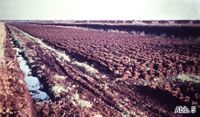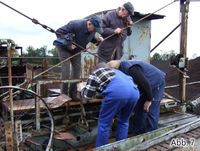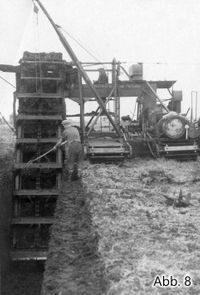Why is Liliput the greatest?
In contrast to the Gigant peat excavator (Station 21 on the bicycle circuit), Liliput (Fig. 2) has proven its worth at the Great Moor near Gifhorn and on other moors.
Excavators for smaller areas were in great demand as number of large areas of moorland covering several hundred hectares diminished. The B45 compact excavator, known as “Liliput”, first appeared in 1950 and as quickly as 1951 five units were deployed in peat-cutting operations. The freely suspended boom (Fig. 3) had a length of 20 to 25 m. The compact Liliput excavators were foolproof and the round sods of fuel peat dried quickly as they were placed on the ground in single strands (Fig. 4) with minimal contact between them (Fig. 6). After the initial drying, they were stacked into small piles (Fig. 5).
Our fuel peat excavator made it onto the museum ground under its own steam. This was possible thanks to the expertise of Friedhelm Tausendfreund, Adolf Schrader, Harald Schrader and Reinhard Wulfes, who spent weeks tinkering and performing test runs (Fig. 7).
This type of excavator was an international success and by the time that demand for fuel peat had died down, it had sold 125 units, including units built under licence. 40 of these remained in Germany, 25 were destined for the Netherlands, 15 went to Finland and two each to France, Poland and Sweden. The other 39 units were shipped to Ireland, where the Liliput was superseded in 1957 by the even more compact B57, dubbed the “Miniput”.
The last fuel peat excavator in the Great Moor near Gifhorn was saved by our founding member Heinrich Wulfes, who thus laid an important foundation stone for our museum.
The Liliput on display here was manufactured in 1956 by Johannes Flügger GmbH & Co. KG in Delmenhorst. It originally had a Büssing engine and was purchased as a new vehicle by Erwin Wolpers from Neudorf-Platendorf. On a good day, some 300 m of moor canal could be excavated by the bucket ladder to a depth of two metres. Figures 8 and 9 show similar excavators employed in the Great Moor. The manner in which the work was performed can easily be recognised here.
Links to other stations in the museum:
<1> <2> <3> <4> <5> <6> <7> <8> <9> <10> <11> <12> <13> <14> <15> <16> <17> <18> <19> <20> <21> <22> <23>
